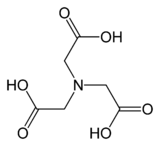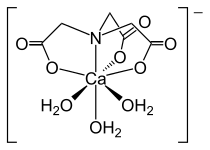Nitrilotriacetic acid
Nitrilotriacetic acid (NTA) is the aminopolycarboxylic acid with the formula N(CH2CO2H)3. It is a colourless solid that is used as a chelating agent, which forms coordination compounds with metal ions (chelates) such as Ca2+, Co2+ , Cu2+, and Fe3+.[5]
 | |
| Names | |
|---|---|
| Preferred IUPAC name
2,2',2''-Nitrilotriacetic acid[1] | |
| Other names | |
| Identifiers | |
3D model (JSmol) |
|
| 1710776 | |
| ChEBI | |
| ChemSpider | |
| DrugBank | |
| ECHA InfoCard | 100.004.869 |
| EC Number |
|
| 3726 | |
| KEGG | |
| MeSH | Nitrilotriacetic+Acid |
PubChem CID |
|
| RTECS number |
|
| UNII | |
| UN number | 2811 |
CompTox Dashboard (EPA) |
|
| |
| |
| Properties | |
| C6H9NO6 | |
| Molar mass | 191.14 [4] |
| Appearance | White crystals |
| Melting point | 246[4] °C (475 °F; 519 K) |
| Insoluble. <0.01 g/100 mL at 23℃ [4] | |
| Thermochemistry | |
Std enthalpy of formation (ΔfH⦵298) |
−1.3130–−1.3108 MJ mol−1 |
| Hazards | |
| GHS pictograms |   |
| GHS Signal word | Warning |
GHS hazard statements |
H302, H319, H351 |
| P281, P305+351+338 | |
| Flash point | 100 °C (212 °F; 373 K) |
| Lethal dose or concentration (LD, LC): | |
LD50 (median dose) |
1.1 g kg−1 (oral, rat) |
| Related compounds | |
Related alkanoic acids |
|
Related compounds |
|
Except where otherwise noted, data are given for materials in their standard state (at 25 °C [77 °F], 100 kPa). | |
| Infobox references | |
Production and use
Nitrilotriacetic acid is commercially available as the free acid and as the sodium salt. It is produced from ammonia, formaldehyde, and sodium cyanide or hydrogen cyanide. Worldwide capacity is estimated at 100 thousand tonnes per year.[6] NTA is also cogenerated as an impurity in the synthesis of EDTA, arising from reactions of the ammonia coproduct.[7]
Coordination chemistry and applications
NTA is a tripodal tetradentate trianionic ligand.[8]
The uses of NTA are similar to those of EDTA, both being chelating agents. It is used for water softening and as a replacement to sodium and potassium triphosphate in detergents, and cleansers.
In one application, NTA as a chelating agent removes Cr, Cu, and As from wood that had been treated with chromated copper arsenate.[9]
Laboratory uses
In the laboratory, this compound is used in complexometric titrations. A variant of NTA is used for protein isolation and purification in the His-tag method.[10] The modified NTA is used to immobilize nickel on a solid support. This allows purification of proteins containing a tag consisting of six histidine residues at either terminus.[11]
The his-tag binds the metal of metal chelator complexes. Previously, iminodiacetic acid was used for that purpose. Now, nitrilotriacetic acid is more commonly used.[12]
For laboratory uses Ernst Hochuli et al. 1987 coupled the NTA ligand and Nickel-ions to agarose beads.[13] This Ni-NTA Agarose is the most used tool to purify his tagged proteins via affinity chromatography.
- NTA complexes
(aq)23views.png) Three views of the structure of [Ni(NTA)(H2O)2]−.
Three views of the structure of [Ni(NTA)(H2O)2]−. Structure of the nitrilotriacetate anion [Ca(NTA)(H2O)3]−.
Structure of the nitrilotriacetate anion [Ca(NTA)(H2O)3]−.
Toxicity and Environment
Nitriloacetic acid can cause eye, skin, and respiratory tract irritation; and can cause kidney and bladder damage. The compound is anticipated to have the potential to cause human cancers.[2]
In contrast to EDTA, NTA is easily biodegradable and is almost completely removed during wastewater treatment.[6] The environmental impacts of NTA are minimal. Despite widespread use in cleaning products, the concentration in the water supply is too low to have a sizeable impact on human health or environmental quality.[14]
References
- Nomenclature of Organic Chemistry : IUPAC Recommendations and Preferred Names 2013 (Blue Book). Cambridge: The Royal Society of Chemistry. 2014. pp. 21, 679. doi:10.1039/9781849733069. ISBN 978-0-85404-182-4.
- "Nitrilotriacetic Acid - Compound Summary". PubChem Compound. USA: National Center for Biotechnology Information. 26 March 2005. Identification. Retrieved 13 July 2012.
- Nitrilotriacetic acid
- ChemBK Chemical Database http://www.chembk.com/en/chem/Nitrilotriacetic%20acid
- Nitrilotriacetic Acid and Its Salts, International Agency for Research on Cancer
- Charalampos Gousetis, Hans-Joachim Opgenorth. "Nitrilotriacetic Acid". Ullmann's Encyclopedia of Industrial Chemistry. Weinheim: Wiley-VCH. doi:10.1002/14356007.a17_377.
- Hart, J. Roger (2005) "Ethylenediaminetetraacetic Acid and Related Chelating Agents" in Ullmann's Encyclopedia of Industrial Chemistry, Wiley-VCH, Weinheim. doi:10.1002/14356007.a10_095
- B. L. Barnett, V. A. Uchtman "Structural investigations of calcium-binding molecules. 4. Calcium binding to aminocarboxylates. Crystal structures of Ca(CaEDTA).7H2O and Na(CaNTA)" Inorg. Chem., 1979, volume 18, pp 2674–2678. doi:10.1021/ic50200a007
- Fang-Chih, C.; Ya-Nang, W.; Pin-Jui, C.; Chun-Han, K. Factors affecting chelating extraction of Cr, Cu, and As from CCA-treated wood. J. Environ. Manag. 2013, 122.
- Liu, Weijing (2016). "Layer-by-Layer Deposition with Polymers Containing Nitrilotriacetate, A Convenient Route to Fabricate Metal- and Protein-Binding Films". ACS Applied Materials & Interfaces. 8 (16): 10164–73. doi:10.1021/acsami.6b00896. PMID 27042860.
- qiaexpressionist
- Lauer, Sabine A.; Nolan, John P. (2002). "Development and characterization of Ni-NTA-bearing microspheres". Cytometry. 48 (3): 136–145. doi:10.1002/cyto.10124. ISSN 1097-0320. PMID 12116359.
- Hochuli, E.; Döbeli, H.; Schacher, A. (January 1987). "New metal chelate adsorbent selective for proteins and peptides containing neighbouring histidine residues". Journal of Chromatography A. 411: 177–184. doi:10.1016/s0021-9673(00)93969-4. ISSN 0021-9673. PMID 3443622.
- Brouwer, N.; Terpstra, P. Ecological and Toxicological Properties of Nitrilotriacetic Acid (NTA) as a Detergent Builder. Tenside Surfactants Detergents 1995, 32, 225-228.